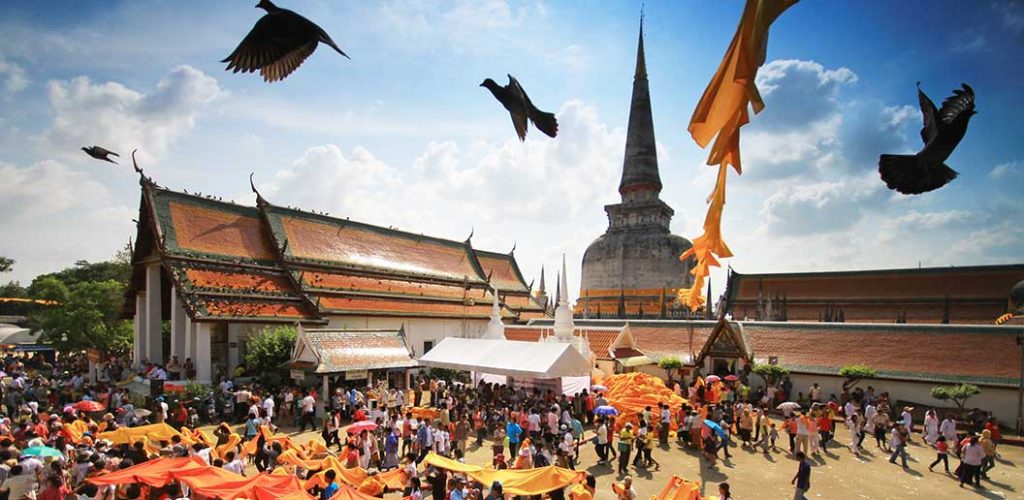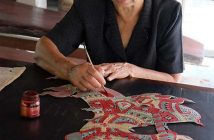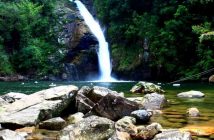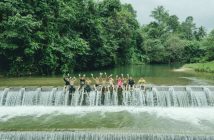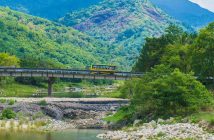When you think of southern Thailand you probably think of the gorgeous Andaman coast, or some beautiful far flung islands ringed with white sands and turquoise waters. But as the experienced traveler would tell you, if you go off-track, you’d find a lot of hidden gems past the highway. One of them is the second biggest province in the South of Thailand, Nakhon Si Thammarat (usually shortened to Nakhon and also known as Muang Kon). At present, Nakhon doesn’t bear high on most itineraries. This is probably because whilst it is in the south of Thailand, it’s not exactly on the beach, and in the words of the Lonely Planet, “not likely to win any beauty contests”, not in comparison to its surrounding neighbors anyway. But it is an ancient city of great importance to Thai history, dating back to the 7th century.
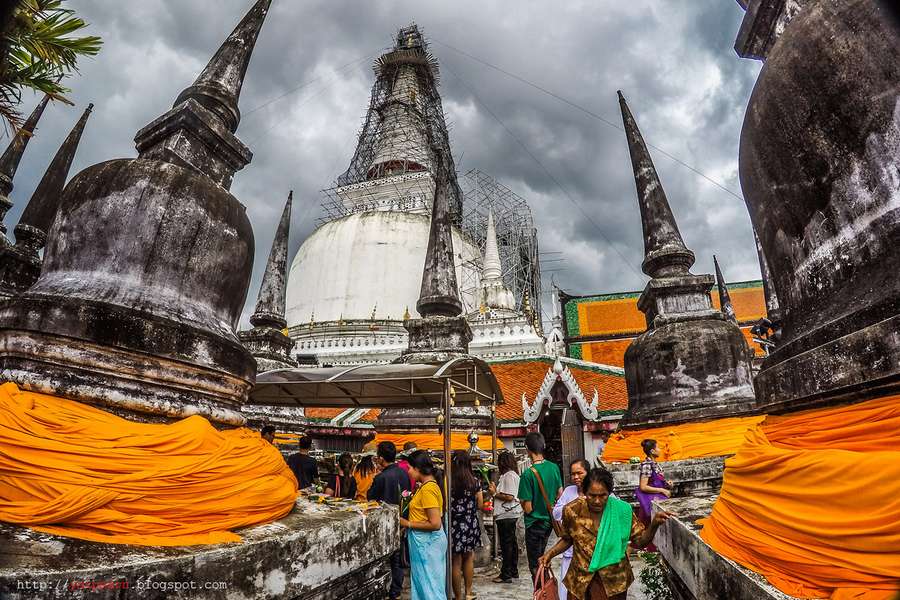 Nakhon Si Thammarat was once the center of art, culture, and marine trading of the region, proven by abundant antiquities and archaeological evidence discovered here. Nakhon, the capital bearing the same name as the province, was an influential trading port for centuries attracting merchants from China, India, Sri Lanka and Europe. Previously, the Kingdom of Ligor, the town chronicles of this time are hardly separable from legend, but they do tell of abandonment and the refounding of the town. This was before scholars recognized Nakhon’s history as Tambralinga, an ancient kingdom on the Malay Peninsula. At the time of the Sukhothai rule, Nakhon Si Thammarat was already listed as one of the kingdoms under control of the Thai and it has remained so during most of its history. Although it was usually known as Ligor to European merchants in the 16th century, by the 19th century, it officially became a part of Thailand.
Nakhon Si Thammarat was once the center of art, culture, and marine trading of the region, proven by abundant antiquities and archaeological evidence discovered here. Nakhon, the capital bearing the same name as the province, was an influential trading port for centuries attracting merchants from China, India, Sri Lanka and Europe. Previously, the Kingdom of Ligor, the town chronicles of this time are hardly separable from legend, but they do tell of abandonment and the refounding of the town. This was before scholars recognized Nakhon’s history as Tambralinga, an ancient kingdom on the Malay Peninsula. At the time of the Sukhothai rule, Nakhon Si Thammarat was already listed as one of the kingdoms under control of the Thai and it has remained so during most of its history. Although it was usually known as Ligor to European merchants in the 16th century, by the 19th century, it officially became a part of Thailand.
It is located on the east side of the Thai peninsula, a couple of hours drive south of Surat Thani, which most folks will pass through on their way to somewhere like Koh Samui. But even with its interesting history, ancient temples and beautiful lush mountains, Nakhon Si Thammarat is disappointingly underrated. The eclectic charms of the coastal city lies in its variety; brimming with ancient sites and unique cuisine
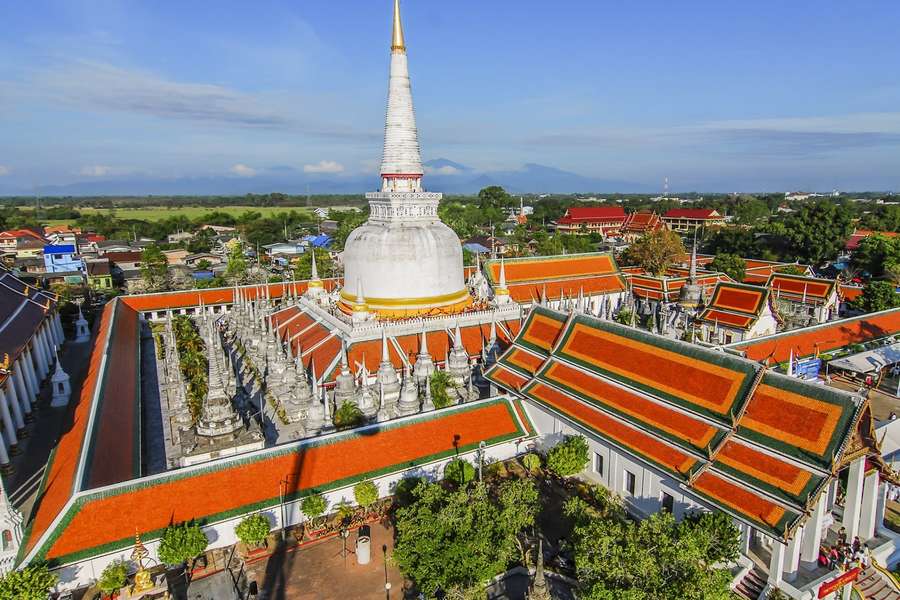 If you flip a 25 satang coin, you’ll find a gigantic Sri Lankan-style stupa called Phra Borommathat Chedi (the Great Noble Relics Stupa). The iconic Buddhist structure is part of the ancient temple, Wat Phra Mahathat Woramahawihan or Wat Phra Mahathat. It is not just the most important temple in the province, but one of the most important Buddhist sites in the whole of Thailand. The chedi is believed to house a tooth of Lord Buddha. Almost as old as the city itself, the stupa of Wat Phra Mahathat was built in the 13th century as the symbol of Theravada Buddhism. The magical thing about Phra Borommathat Chedi is that it never casts a shadow on the ground! In addition, you can join one of Southern Thailand’s greatest Buddhist festivals, Hae Pha Khuen That. On Makha Bucha Day (the third full moon) and Visakha Bucha Day (the sixth full moon), Buddhists make merit by parading a large piece of cloth up and wrap it around the stupa. A little further down from Wat Phra Mahathat lies Wat Thao Kot. This old riverside temple complex contains five temples that are slowly falling apart. The temples themselves aren’t terribly impressive, but the location, with the jungle reclaiming its own, is very atmospheric. On a walk along the city’s main Ratchadamnoen Road you can discover the manifold traces which these people from so many different cultures and religions left here. The city walls from the 12th century will give you an impression of how significant this city has once been, and you can also marvel at the wood carvings on the façade of the monks’ residences Wat Wang Tawan Tok. Besides the wide temple area, the city walls are located in the heart of the city, within the public park where you can see many locals doing their evening exercise, with the sunset and various street vendors are set up around park. Moreover, within the same area, not so far, City Pillar Shrine elegantly catches your eyes with its snow-white form.
If you flip a 25 satang coin, you’ll find a gigantic Sri Lankan-style stupa called Phra Borommathat Chedi (the Great Noble Relics Stupa). The iconic Buddhist structure is part of the ancient temple, Wat Phra Mahathat Woramahawihan or Wat Phra Mahathat. It is not just the most important temple in the province, but one of the most important Buddhist sites in the whole of Thailand. The chedi is believed to house a tooth of Lord Buddha. Almost as old as the city itself, the stupa of Wat Phra Mahathat was built in the 13th century as the symbol of Theravada Buddhism. The magical thing about Phra Borommathat Chedi is that it never casts a shadow on the ground! In addition, you can join one of Southern Thailand’s greatest Buddhist festivals, Hae Pha Khuen That. On Makha Bucha Day (the third full moon) and Visakha Bucha Day (the sixth full moon), Buddhists make merit by parading a large piece of cloth up and wrap it around the stupa. A little further down from Wat Phra Mahathat lies Wat Thao Kot. This old riverside temple complex contains five temples that are slowly falling apart. The temples themselves aren’t terribly impressive, but the location, with the jungle reclaiming its own, is very atmospheric. On a walk along the city’s main Ratchadamnoen Road you can discover the manifold traces which these people from so many different cultures and religions left here. The city walls from the 12th century will give you an impression of how significant this city has once been, and you can also marvel at the wood carvings on the façade of the monks’ residences Wat Wang Tawan Tok. Besides the wide temple area, the city walls are located in the heart of the city, within the public park where you can see many locals doing their evening exercise, with the sunset and various street vendors are set up around park. Moreover, within the same area, not so far, City Pillar Shrine elegantly catches your eyes with its snow-white form.
The South also has its own giant swing and it’s one of the only two in Thailand. While there, you’ll find the Ho Phra Isuan and the Ho Phra Narai. Inside these shrines are religious images such as Shiva Linga, the image of Vishnu and other Hindu gods.
A visit to the Nang Talung Museum at Ban Suchart Subsin is a real treat and is highly recommended if you are in Nakhon Si Thammarat. The museum features an impressive collection of shadow puppets, collected by the Subsin family from various regions of Thailand and some other countries including China, Cambodia and India. In common with other areas of Asia, Thailand has a long tradition of storytelling using shadow puppets. The content of the stories and the figures used by puppeteers vary depending on the region of Thailand. In the south of Thailand, the shadow puppet performances combine influences from Malaysia and Thai Muslim traditions. National Artist, the late Suchart Subsin, played a pivotal role in preserving this ancient performing art. Ban Suchart Subsin is also a venue where visitors can see southern Thai shadow puppet performances, known as ‘nang talung‘, performed by members of Suchart’s family. In ‘nang talung‘ performances at Ban Suchart Subsin the humor can be bawdy and some of the tales of morals and values have been given a clever contemporary twist to keep them relevant to a new generation. Characters from the nang talung plays have become synonymous with the city and depictions of them can be seen in various locations around Nakhon Si Thammarat and on souvenirs from the area. The award-winning museum has won local and international praise for its role in education and preserving ancient folk arts.
 Visitors to the shadow puppet museum can go inside the workshop to see all aspects involved in making the figures which includes designing and cutting out the patterns, tanning the leather and painting the puppets. The museum is open daily, but it is advisable to call in advance to let them know you are coming so that they can prepare the shadow puppet performance.
Visitors to the shadow puppet museum can go inside the workshop to see all aspects involved in making the figures which includes designing and cutting out the patterns, tanning the leather and painting the puppets. The museum is open daily, but it is advisable to call in advance to let them know you are coming so that they can prepare the shadow puppet performance.
Approximately 30 kilometers west of the city, the villagers of Ban Kiriwong have formed a local co-operative producing arts and crafts. The villagers’ lives are entwined with nature and apart from organic fruit farming, many local workshops are available. From fruit processing and soap making to tie-dying and beading, everything is made from materials found in Kiriwong. With river views, some quaint antique shops and good food aplenty, Ban Kiriwong is an interesting half-day tour. The sights of green surroundings, crystal clear streams and majestic mountains are refreshing enough, but the air itself is even more rejuvenating.
With Thailand’s purest ozone as the village’s main claim to fame, Kiriwong Village draws a lot of nature lovers, especially city dwellers and cycling lovers. The village itself sits at the foot of the mountain known as Khao Luang, the highest peak in the South. Khao Luang lies within the vicinity of Khao Luang National Park. Dominated by verdant jungles, the area offers ultimate tranquility with a sense of adventure. The park is also home to waterfalls like Krung Ching Waterfall, caves, over 300 kinds of orchids and a type of fern that is known to exist for 180 million years.
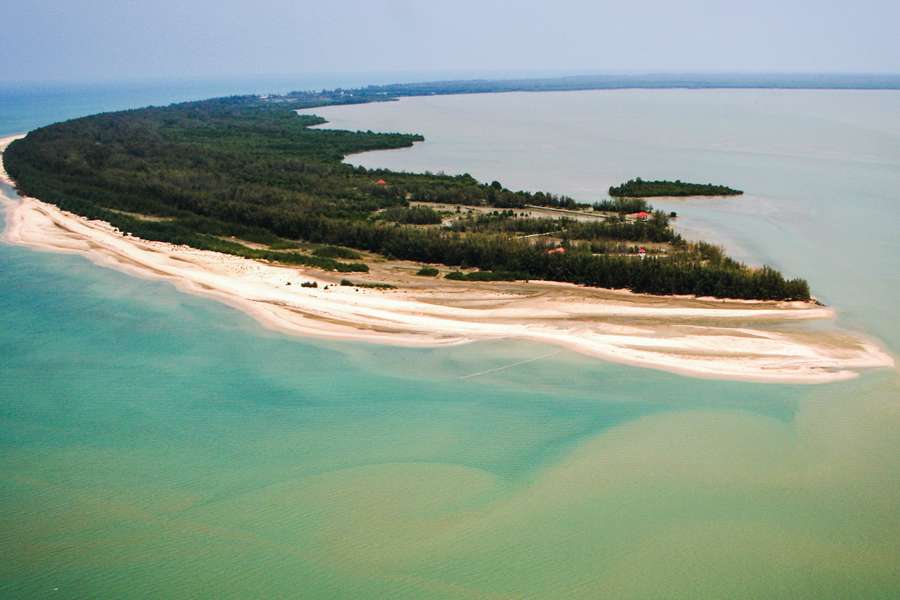 Pak Phanang is one of the best-known destinations in Nakhon Si Thammarat province. Jutting out into the sea, Pak Phanang (locally known as Pak Nang) was once a bustling port town. Though a severe storm hit the area in 1962 and Pak Phanang is no longer as busy as it was, its charms have recently been restored. The district is home to a royal project on the river estuary which separates sea water from the fresh water upstream creating opportunities for farmers and fishermen alike. Pak Phanang is also home to the unique ‘bird condominiums’ where swifts birds’ nests are harvested to make birds nest soup. You can also stroll in the 100-year-old Pak Phanang Market and take in the sight of old wooden houses. The locals here live simply—fishing and running their own shops selling sweets and fruit including Siamese Ruby pomelo. One of the top hand-woven products in Thailand, Yan Lipao basketry was born here in Muang Kon. The fine, strong vines of the lipao plant are transformed into elegant yet durable baskets, bags, boxes and a lot of other utensils by the meticulous hands of the locals.
Pak Phanang is one of the best-known destinations in Nakhon Si Thammarat province. Jutting out into the sea, Pak Phanang (locally known as Pak Nang) was once a bustling port town. Though a severe storm hit the area in 1962 and Pak Phanang is no longer as busy as it was, its charms have recently been restored. The district is home to a royal project on the river estuary which separates sea water from the fresh water upstream creating opportunities for farmers and fishermen alike. Pak Phanang is also home to the unique ‘bird condominiums’ where swifts birds’ nests are harvested to make birds nest soup. You can also stroll in the 100-year-old Pak Phanang Market and take in the sight of old wooden houses. The locals here live simply—fishing and running their own shops selling sweets and fruit including Siamese Ruby pomelo. One of the top hand-woven products in Thailand, Yan Lipao basketry was born here in Muang Kon. The fine, strong vines of the lipao plant are transformed into elegant yet durable baskets, bags, boxes and a lot of other utensils by the meticulous hands of the locals.
 The pristine beaches of Khanom are the perfect antidote to claims that beaches in southern Thailand are crowded and too commercialized. Khanom is famous for its pink dolphins, known in Thai as ‘loma si chompoo‘, which tend to hang around specific areas off the coast increasing the likelihood of seeing them if you arrange a trip with the local boatmen.
The pristine beaches of Khanom are the perfect antidote to claims that beaches in southern Thailand are crowded and too commercialized. Khanom is famous for its pink dolphins, known in Thai as ‘loma si chompoo‘, which tend to hang around specific areas off the coast increasing the likelihood of seeing them if you arrange a trip with the local boatmen.
The easiest way to get to Nakhon Si Thammarat from Bangkok is by air. Nok Air and Air Asia both operate flights to the small airport, 15 km north of the city centre. Air Asia also operates a direct service from Chiang Mai to nearby Surat Thani where it’s possible to make transfers by taxi or mini-bus south to Nakhon Si Thammarat. If you are staying in the beach area of Khanom in the north of Nakhon Si Thammarat province, the airport at Surat Thani airport is another option. Alternatively, you can take the train from the Hua Lamphong train station in Bangkok. The journey is longer, taking fifteen hours although you can also take the bus which departs from Bangkok’s Southern Bus terminal. If you’re in the region to explore Ko Samui, Ko Pha Ngan or Ko Tao, Surat Thani has good connections with Nakhon Si Thammarat. Air-conditioned buses are frequent between the two cities taking approximately 2.5 hours. There are also regular buses to Khanom if you are heading to the beach.
 A charming alternative away from the busier tourist areas in the south of Thailand, Nakhon Si Thammarat is more than an ancient city. It has survived and flourished. Ruins of ancient city walls have been revived. Century-old houses are well-preserved. And don’t skip out on the food. Families have long since passed down recipes for local delicacies such as bak kut teh (pork bone tea soup), kanom jeen sen sod (freshly prepared Thai rice flour noodles) and pad mee muang kon (Nakhon Si Thammarat-style stir-fried noodles).
A charming alternative away from the busier tourist areas in the south of Thailand, Nakhon Si Thammarat is more than an ancient city. It has survived and flourished. Ruins of ancient city walls have been revived. Century-old houses are well-preserved. And don’t skip out on the food. Families have long since passed down recipes for local delicacies such as bak kut teh (pork bone tea soup), kanom jeen sen sod (freshly prepared Thai rice flour noodles) and pad mee muang kon (Nakhon Si Thammarat-style stir-fried noodles).
So, whether you’re looking for the authentic Thai experience or just want to get away from foreigners for a while, Nakhon Si Thammarat is the place for you.


